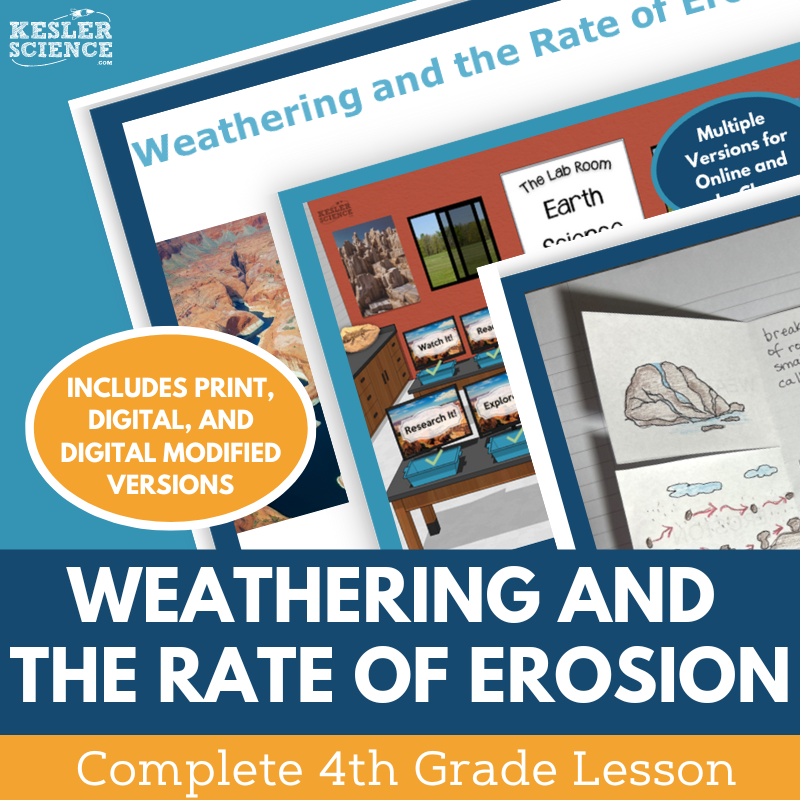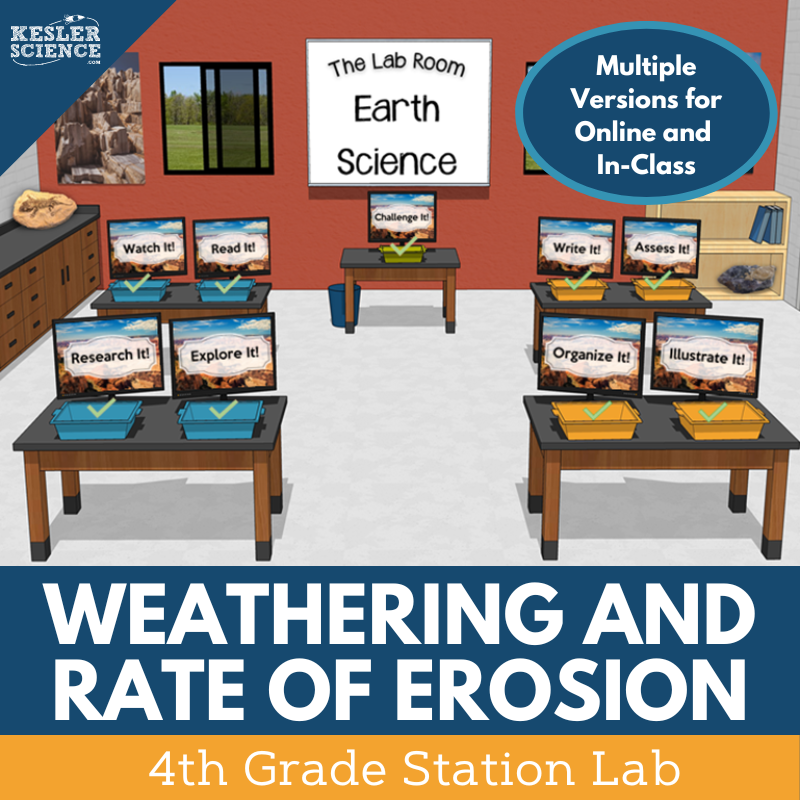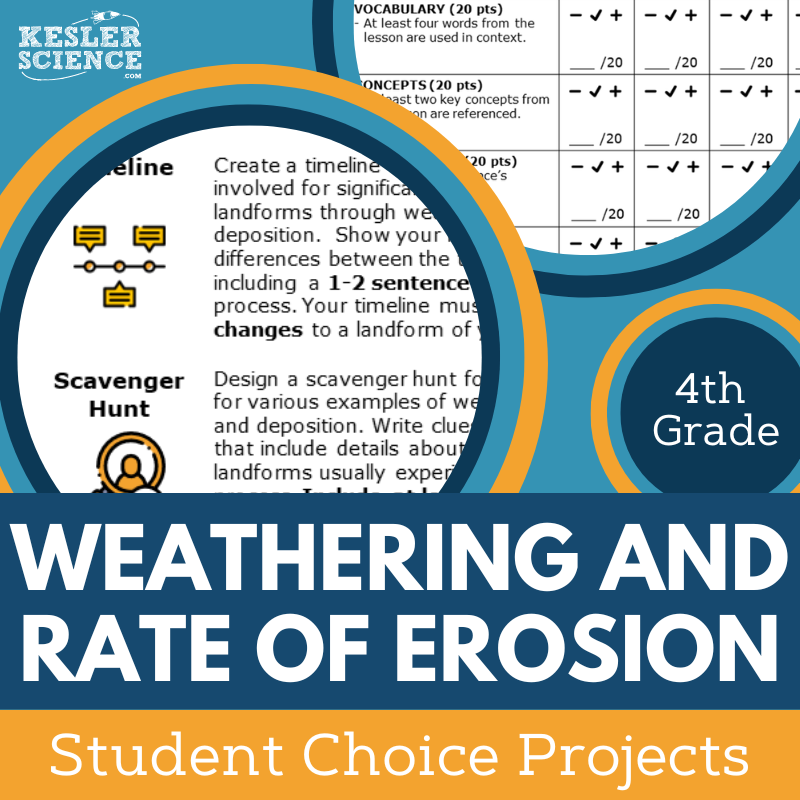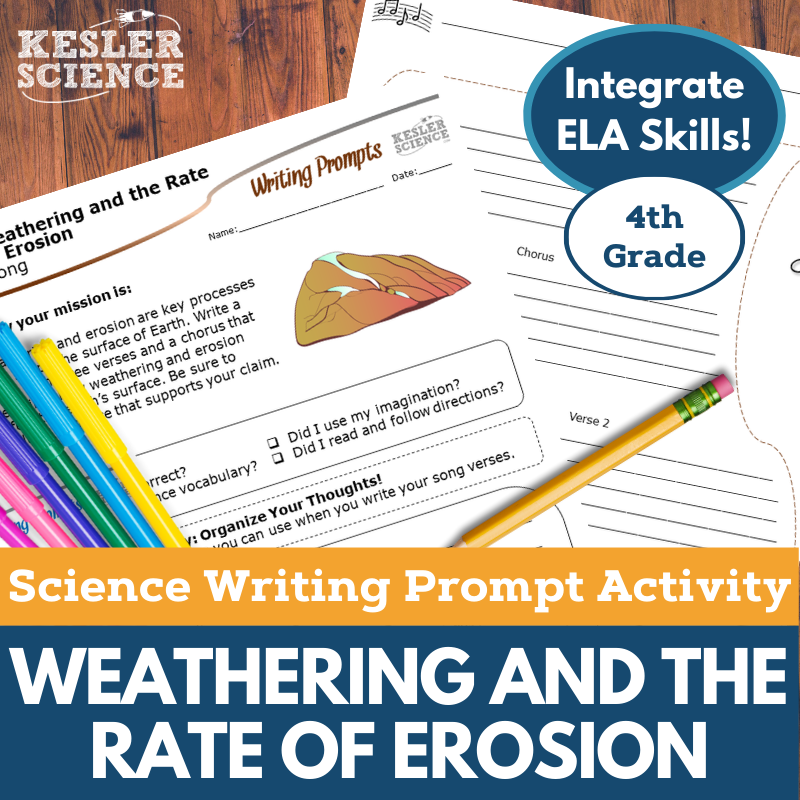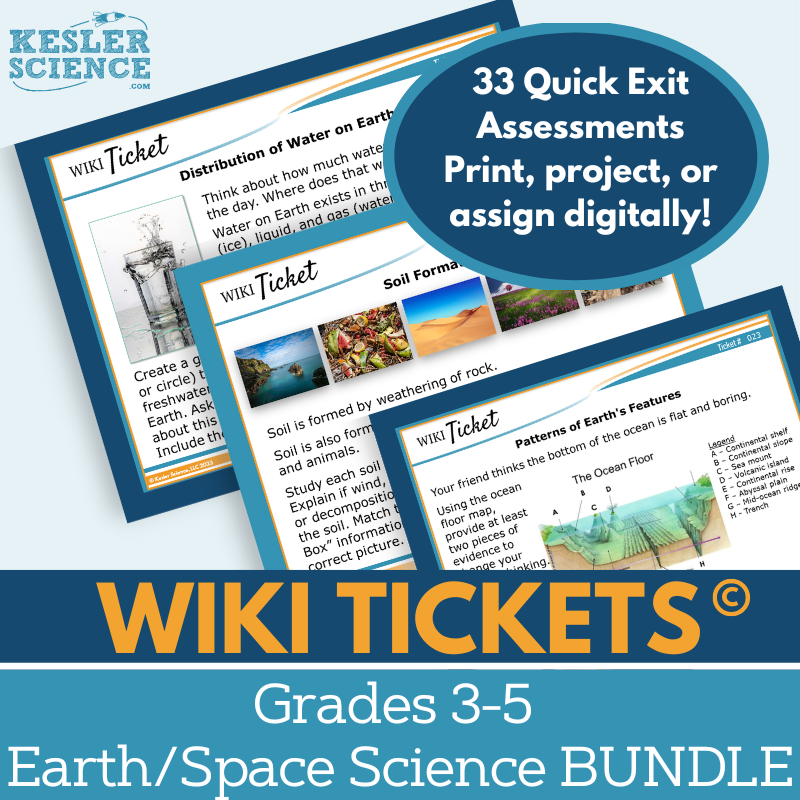Weathering and Rate of Erosion Activities for 4th Grade Science
The Kesler Science Weathering and Rate of Erosion resources provides student-centered materials for teaching 4th graders about the processes that shape Earth's surface. The resources below will give students a comprehensive understanding of weathering and erosion. All of the following materials are also included in the Kesler Science Membership.
The Kesler Science Weathering and Rate of Erosion 4th Grade Complete 5E Lesson provides all the materials needed to teach a comprehensive, student-driven, multi-day lesson. With minimal prep, teachers can guide students through an engaging exploration of weathering and erosion while focusing on their success.
Students will explore essential questions such as the effects of water, ice, wind, and plants on rocks and factors that influence the speed of erosion. The lesson includes differentiated materials for diverse learning needs, and it can be used in both digital and printable formats. Editable PowerPoints, interactive notebooks, and Spanish translations ensure maximum flexibility for all learners.
Following the 5E model, the lesson covers Engagement, Exploration, Explanation, Elaboration, and Evaluation. It includes input stations like hands-on activities, reading, research, and videos, as well as output stations for students to demonstrate their understanding. Additionally, a bonus challenge station offers extension activities for advanced learners. This comprehensive lesson is designed for both in-person and virtual learning environments.
The Kesler Science Weathering and Rate of Erosion 4th Grade Complete 5E Lesson provides all the materials needed to teach a comprehensive, student-driven, multi-day lesson. With minimal prep, teachers can guide students through an engaging exploration of weathering and erosion while focusing on their success.
Students will explore essential questions such as the effects of water, ice, wind, and plants on rocks and factors that influence the speed of erosion. The lesson includes differentiated materials for diverse learning needs, and it can be used in both digital and printable formats. Editable PowerPoints, interactive notebooks, and Spanish translations ensure maximum flexibility for all learners.
Following the 5E model, the lesson covers Engagement, Exploration, Explanation, Elaboration, and Evaluation. It includes input stations like hands-on activities, reading, research, and videos, as well as output stations for students to demonstrate their understanding. Additionally, a bonus challenge station offers extension activities for advanced learners. This comprehensive lesson is designed for both in-person and virtual learning environments.
The Kesler Science Weathering and the Rate of Erosion Station Lab is an engaging, modular, student-led activity for 4th grade students to explore weathering and erosion. This station lab allows students to independently observe and measure the effects of weathering and erosion caused by water, ice, wind, and vegetation, making it easy for teachers to facilitate student-driven learning with minimal prep.
With eight differentiated stations and a challenge station for early finishers, students experience multimodal learning through hands-on activities, reading, research, videos, and interactive tasks. The stations are designed to be completed independently or in small groups and include materials that can be easily found in most classrooms.
The lab includes a variety of activities, such as reading passages (available in Spanish and English), writing prompts, experiments, and digital versions for virtual learning. This flexible and engaging approach ensures that all students, regardless of learning style, can demonstrate their understanding of weathering and erosion.
The Kesler Science Weathering and the Rate of Erosion Station Lab is an engaging, modular, student-led activity for 4th grade students to explore weathering and erosion. This station lab allows students to independently observe and measure the effects of weathering and erosion caused by water, ice, wind, and vegetation, making it easy for teachers to facilitate student-driven learning with minimal prep.
With eight differentiated stations and a challenge station for early finishers, students experience multimodal learning through hands-on activities, reading, research, videos, and interactive tasks. The stations are designed to be completed independently or in small groups and include materials that can be easily found in most classrooms.
The lab includes a variety of activities, such as reading passages (available in Spanish and English), writing prompts, experiments, and digital versions for virtual learning. This flexible and engaging approach ensures that all students, regardless of learning style, can demonstrate their understanding of weathering and erosion.
The Kesler Science Weathering and Rate of Erosion Student Choice Projects offer 4th grade students a variety of project options to showcase their understanding of weathering and erosion. With six different project choices and an option to design their own, students can choose the format that best fits their learning style. A flexible grading rubric allows assessments by teachers, peers, or students themselves.
These dynamic projects cater to different learning needs, with two versions available to support remediation or provide additional challenges. The projects are adaptable, enabling teachers to modify the rubric as needed and providing multimodal options to allow creative expression.
Designed with minimal prep, these projects use everyday classroom supplies like paper, markers, and scissors. Many projects are also suitable for digital completion, with some requiring basic crafting materials for building models.
The Kesler Science Weathering and Rate of Erosion Student Choice Projects offer 4th grade students a variety of project options to showcase their understanding of weathering and erosion. With six different project choices and an option to design their own, students can choose the format that best fits their learning style. A flexible grading rubric allows assessments by teachers, peers, or students themselves.
These dynamic projects cater to different learning needs, with two versions available to support remediation or provide additional challenges. The projects are adaptable, enabling teachers to modify the rubric as needed and providing multimodal options to allow creative expression.
Designed with minimal prep, these projects use everyday classroom supplies like paper, markers, and scissors. Many projects are also suitable for digital completion, with some requiring basic crafting materials for building models.
The Kesler Science Weathering and the Rate of Erosion Science and ELA Integrated Writing Activity lets 4th grade students explore weathering and erosion through creative expression. Using a song as the prompt, students can demonstrate their understanding of Earth processes while engaging in a fun and interactive project. Designed for both in-person and virtual learning, this activity fosters students' critical thinking and writing skills.
Aligned to TEKS and NGSS, this low-prep activity encourages science reasoning and exploration. It includes both full and half-sized handouts, a teacher guide with rubrics, and a digital version that allows for flexible classroom use. This student-centered approach is ideal for elaboration, review, or even make-up work.
The activity offers a variety of uses such as a cross-curricular tool, pre-test assessment, or as a student choice project. It’s an excellent way to integrate science and language arts, while also offering differentiation for diverse learner needs.
The Kesler Science Weathering and the Rate of Erosion Science and ELA Integrated Writing Activity lets 4th grade students explore weathering and erosion through creative expression. Using a song as the prompt, students can demonstrate their understanding of Earth processes while engaging in a fun and interactive project. Designed for both in-person and virtual learning, this activity fosters students' critical thinking and writing skills.
Aligned to TEKS and NGSS, this low-prep activity encourages science reasoning and exploration. It includes both full and half-sized handouts, a teacher guide with rubrics, and a digital version that allows for flexible classroom use. This student-centered approach is ideal for elaboration, review, or even make-up work.
The activity offers a variety of uses such as a cross-curricular tool, pre-test assessment, or as a student choice project. It’s an excellent way to integrate science and language arts, while also offering differentiation for diverse learner needs.
The Kesler Science Earth/Space WIKI Tickets provide fun, easy formative assessments for 3rd–5th grade science. This set includes 33 engaging exit tickets aligned to NGSS and TEKS, covering topics like the water cycle, Earth's rotation, weather patterns, and natural resources.
Each topic features five formats: a full-screen display for projection, three printable handout sizes, and an interactive digital version compatible with PowerPoint and Google Slides. A bonus table of contents file ensures easy standard alignment.
WIKI Tickets (“What I Know Is”) serve as exit tickets, bellringers, or quick checks for understanding, making them a flexible tool for both in-person and virtual learning environments.
The Kesler Science Earth/Space WIKI Tickets provide fun, easy formative assessments for 3rd–5th grade science. This set includes 33 engaging exit tickets aligned to NGSS and TEKS, covering topics like the water cycle, Earth's rotation, weather patterns, and natural resources.
Each topic features five formats: a full-screen display for projection, three printable handout sizes, and an interactive digital version compatible with PowerPoint and Google Slides. A bonus table of contents file ensures easy standard alignment.
WIKI Tickets (“What I Know Is”) serve as exit tickets, bellringers, or quick checks for understanding, making them a flexible tool for both in-person and virtual learning environments.
Year-Round Resources
These year-round activities will increase your students' understanding of many middle school science topics. All of these activities are also included in the Kesler Science Membership.
Visual Data & Graphing
You're not alone if your students struggle with understanding graphs, charts, and tables. It's a skill that takes an enormous amount of practice. This resource will help students build a strong foundation in analyzing data and creating their own data visualizations.
Bell Ringers and Warm-Ups
These middle school science bell ringers are an excellent way to engage your students as soon as they walk into your classroom. This comprehensive FULL YEAR resource includes everything you need to start off each science class with an interesting warm-up activity.
Review Board Games
Each game board has been carefully designed to keep students engaged. There are 10 different action spaces on each board and dozens of question cards. All of the actions are related to science concepts and keep the students motivated throughout the game.
Each game is ready to play. Simply print out the board and the cards and let the students enjoy reviewing nine different units.
Essential Questions
Below are the essential questions associated with the lessons and activities included in this unit. This topic is only one of more than 100 middle school science topics included in the Kesler Science Membership.
-
What effect do water, ice, wind, and plants have on rock?
-
What factors can make erosion happen faster or slower?
Kesler Science Membership
Imagine never having to search for another middle school science lesson again. The membership gives you access to ALL of the Kesler Science products in one place (Yes, including everything above).
Say goodbye to long hours of lesson prep.

